If you’re reading this, chances are you’ve already been on Facebook several times today. The social media giant (so ubiquitous that its name is used as a noun, verb, and adjective) boasts 1.18 billion daily active users ranging from CEOs to companies to students. Despite this large community, online marketers and advertisers still find it hard to connect with this vast nation of thumbs-up givers.
For new brands that are just entering the digital marketplace, just sharing your posts isn’t enough. Neither is blindly throwing money at the problem, hoping it will magically lift your company’s information to the very top of the ever-changing daily feeds. Of course, investing money in a solid optimization plan can work very well, but only if you are targeted and deliberative about how you cultivate your audience. Facebook advertising can seem easier to manage and launch than a PPC campaign or programmatic display, which often leads to the downfall of many brands.
Creating an optimized Facebook Ad is one of the easiest ways to spend your marketing budget wisely, lowering your CPA and leading to a positive return on investment.
In today’s crowded marketplace, creating the perfect optimized ad may seem as fleeting and elusive as capturing spring in Minnesota, but there are in fact some no-fail foundational principles.
Four Tenets of a Good Conversion-optimized Facebook Ad:
1. It must be visually appealing
Although Facebook readers may appear like Victorian novel-readers when compared to, say, Snapchat users, the fact remains that their attention spans are still short. If your ad doesn’t look good, they aren’t sticking around.
Facebook likes pretty things, too: visual content is more likely to appear favorably in its placement algorithm. Readers are also more likely to remember and share those ads that have a strong visual element.
Where to start? Check here for an in-depth guide to image sizes for various Facebook ad units as well as tips on posting visually appealing content.
2. It must be relevant
In Facebook as in all advertising, relevance is crucial for success. The grooviest ad in the world is pointless if it doesn’t mean anything to your intended audience. Remember, you are spending money on every view or click on your ad (depending on your chosen settings), so it’s critical that you make your dollars count.
Look closely at your target customers. Review your geographic/demographic data on where they live, work, play, spend.. (You don’t have demographic data? Get some, stat!) Find a way to take what you know about their choices, then turn it on its head to surprise them. (Great ad agencies followed these rules way back in the day too, when even one computer may have taken up two rooms. Check out this Volkswagen ad that went the equivalent of viral in the print era…)
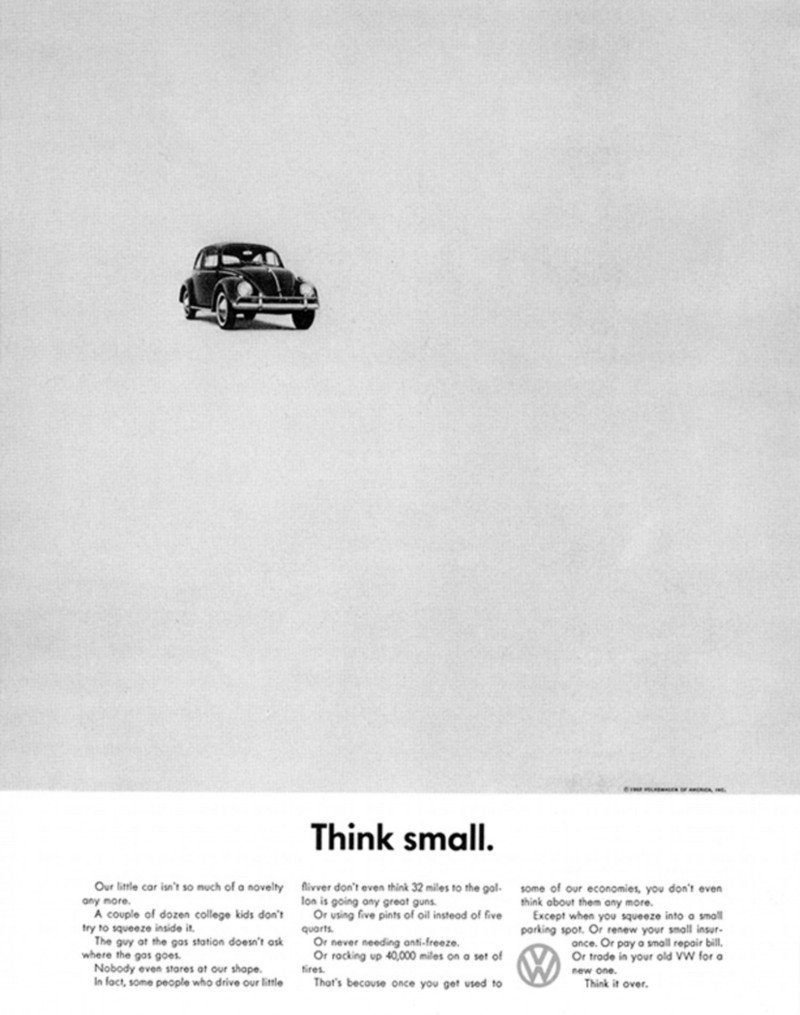
Facebook launched a feature back in February 2015 on the Facebook advertising platform. Similar to Ad Rank in Google AdWords, this tool rates your ads and assigns a relevance score. The higher your score, the more relevant your destination page, ad copy, and image are to your target audience — and the more favorably your ads will be treated by Facebook.
3. It must include an enticing value proposition
What does value proposition do? It tells the reader what’s in it for them, should they click on your ad to learn more about your services/products. It lets them know why it’s worth their time.
A good value prop provides captivating, credible, and concrete reasons why your products and services are different and better. Pay close attention to the credibility element: Saying, “Breadheads makes the best sandwiches in the world” is entirely subjective and essentially meaningless; it won’t drive traffic to your company’s Facebook page, let alone lead to any conversions.
However, if your ad proclaims, “Over 1 million people reached sandwich nirvana at Breadheads in 2017…are you ready to raise your desk-lunch game? Check out your local Breadheads and get 20% off your first order,” then you have reached your target audience (hungry, time-pressed workers who live locally and are careful with their money), piqued their interest, and (if you put a trackable code on your coupon, which of course you did) created a quantitative way to measure your ROI.
You can get more samples of ads with solid value propositions here.
4. It must have a clear call to action
No matter how relevant and beautiful your ad is, if it has no call to action (CTA), it’s a waste of money and effort. Viewers may like it, but they aren’t going to do anything about it. Your job is to get them up off the metaphorical couch and clicking away to their next steps!
Including a CTA such as “Buy now and save A%,” or “Limited-time offer–these laser cat socks are GONE next Tuesday!” is the equivalent of a rousing speech before a battle. It lights a fire under viewers, instills a sense of urgency, and gives them clear directives on how to follow through with their desires and accomplish their goals.
3 Primary Facebook Ad Formats:
The Right-column Ad
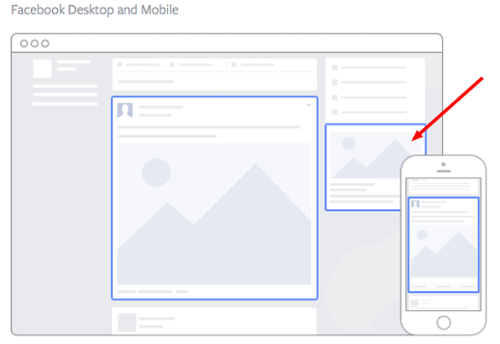
Source: Facebook
This is the most traditional format on Facebook. It’s the first ad format Facebook offered, and it’s still in use today. When using these ads, clients often experienced less expensive clicks and conversions.
To ensure that the right column ad becomes successful, it must have a good visual, be relevant, have a good value proposition, and have a clear call-to-action. Look at an example from Club W (now called Winc).
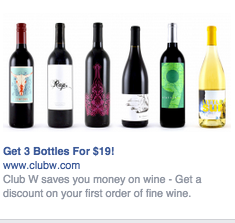
What makes this sample Facebook ad successful?
- It is visually appealing. The visual is simple, clear, and targeted to all wine-lovers.
- It is relevant. This came up in my wine-obsessed colleague’s News Feed. The algorithms have found the right target!
- It includes an enticing value proposition. Get 3 bottles for $19? Definitely a good deal in most peoples’ eyes. The ad also entices viewers with an additional offer: “Get a discount on your first order of wine”.
- It has a strong call to action. The word “get” is a strong, active call-to-action word, and it is used twice in the ad. Adding a time limit on the offer, however, would have added even greater urgency and appeal to the offer.
Desktop News Feed Ad
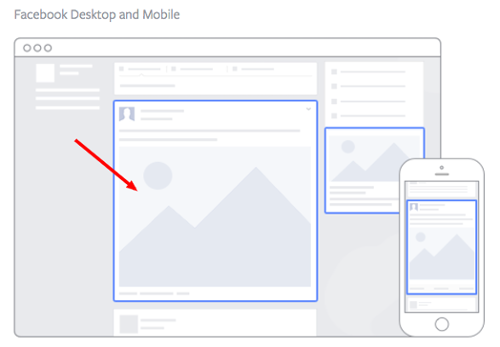
Source: Facebook
This format appears right in the user’s News Feed when users access Facebook on a desktop mode. As a result, it looks more like native advertising. These formats tend to have a higher engagement rate than the right column ads, but they also tend to be more expensive.
To warrant their higher price tags, these ads must be both visually appealing and engaging; they must also follow Facebook’s best practices for organic posts. Take a look at an Amazon ad in this format on a desktop:
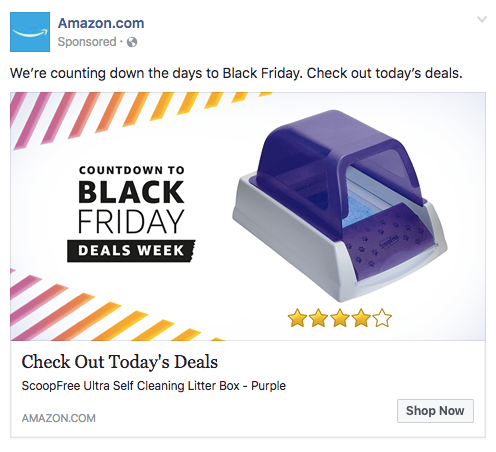
Here’s what makes this ad successful:
- It is visually appealing. This image is not only larger than the right column ad display, but also uses strong directional lines, white space, and warm colors to draw viewers’ eyes toward the featured product.
- It is relevant. The product is aimed at the people most likely to purchase it.
- It includes an enticing value proposition. Amazon shares the strong customer ratings below an image of the product, offering instant credibility.
- It has a clear call to action. Amazon instructs the viewer to click on its ad today…this strong active command, with a time limit attached, is the kind of powerful CTA language that engenders multiple clicks.
The Mobile News Feed Ad
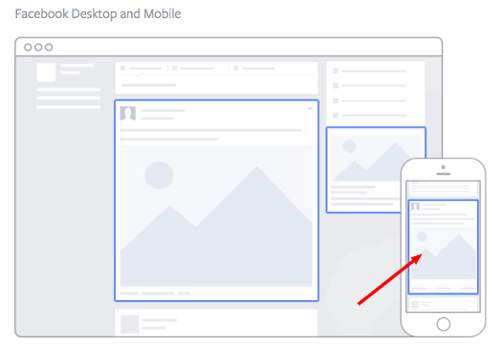
Source: Facebook
Just like the desktop News Feed ad, the mobile News Feed ad appears in the user’s mobile News Feed only. This format makes the ad appear just like organic posts from the preferred pages and people that viewers follow.
An example of a mobile News Feed ad is shown below:
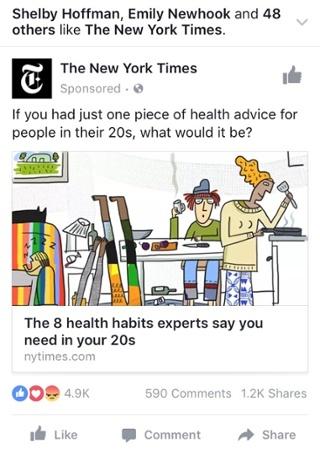
Here’s what makes this ad successful:
- It has enticing visuals: The quirky cartoon is eye-catching and draws attention as users scroll through their mobile News Feed.
- It includes an enticing value proposition: The ad shows which of the viewer’s Facebook friends have also liked, or presumably read, The New York Times. This is positive peer pressure that works!
- It has a clear call to action. This ad is dedicated to increasing the page’s likes, a clear and focused goal. By asking a question in the ad, the call to action compels the viewer to click the article and learn more.
Now that we have covered the basics in formats, let us dig into optimizing Facebook ad conversion.
Facebook Ad Conversion Optimization Best Practices
There are lots of articles published on Facebook Ad conversion optimization. Most of these articles only give basic advice such as “How to create a Facebook audience” or “How to Install a Facebook Pixel,” which are not very helpful in crafting a strategic digital marketing plan.
The first step to mastering this aspect of digital marketing is gaining an understanding of how Facebook ad conversion optimization actually works. Facebook Ad conversion optimization implies that the outcomes of your campaign will be significantly improved, or optimized. Optimization is one of the key things that differentiates a successful social media campaign from those that are merely serviceable.
Optimizing your Facebook ad conversion offers the following benefits:
- Boosts your ads’ click-through rates
- Increases your sales results for the same ad budget
- Lowers your ad campaign’s cost-per-click
- Lowers your cost-per-acquisition
- Reaches even more high-ROI audiences
Do you want to outpace your competitors and reach out to all your target audience members? Then you need to optimize your ads both before and after publishing them on Facebook. The good news is that it’s worth both the effort and time.to do this right from the start. Talking about optimizing your Facebook ads, here are 7 easy steps that you can implement on your campaigns right away:
Step 1: Optimize likes and shares for your Facebook ads
Put simply, the likes and shares earned by your Facebook ads are a form of social proof. They are a sign to your viewers that other like-minded individuals support your product or business, thus adding to its perceived intrinsic value.
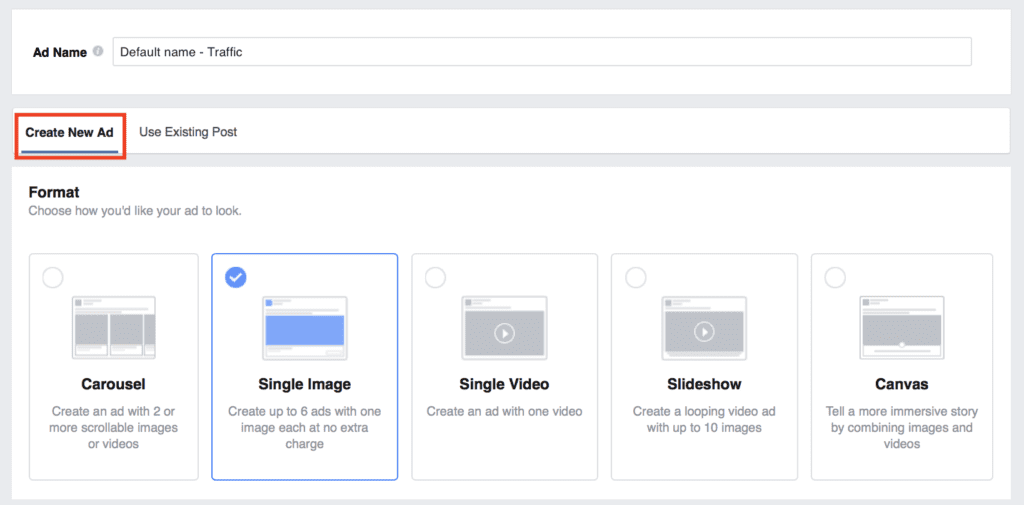
There are two main options available when setting up a Facebook ad campaign. The default option is “create new ads for every ad set and campaign.” The other choice is the “use the existing post” option. This latter choice is actually an incredibly efficient way of optimizing your ads’ likes and shares.
The “use existing post” option gives users the opportunity to gather all the post engagements of campaigns under one single umbrella ad.
Have you ever wondered how some advertisers amass hundreds or thousands of likes and shares under their Facebook campaigns? There is a high probability they are using this optimization step. The simplest way to set up multiple ad campaigns via the “use existing post” option is to have initially published a promotional post on your company’s Facebook Page. After this, you can always re-select this post each time you are setting up new A/B test variations or new ad campaigns.
Step 2: Using the FTO (fast take-off) tactic
Sometimes, campaign take-off can be delayed and take some time. It can often take days before a user has enough campaign results to start optimizing, especially when working with small budgets.
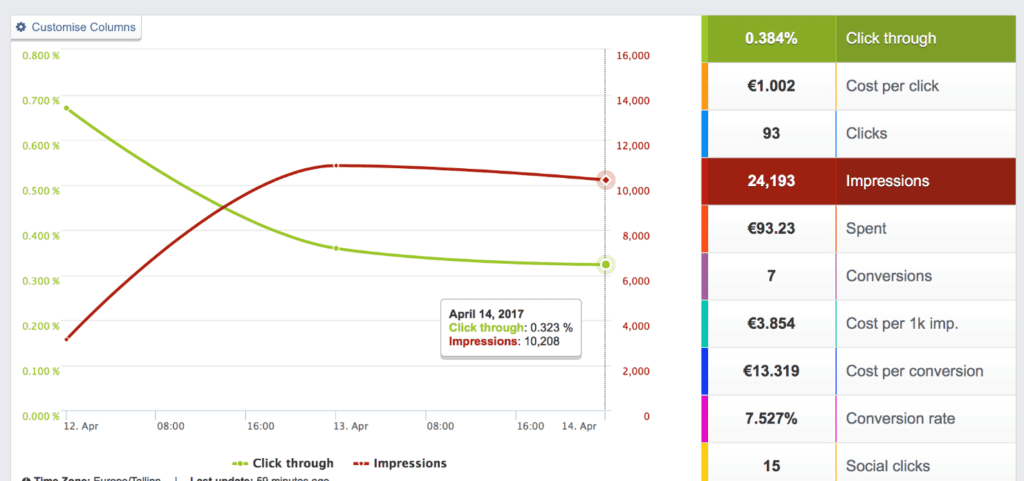
But you can accelerate this Facebook ads conversion optimization process by utilizing the FTO (fast take-off) method. Here are some key things you can do to make sure the fast take-off tactic works:
- After the initial campaign take-off, lower your ad budgets so that they align with your planned total budget.
- Try to avoid the use of accelerated delivery, as this often makes Facebook focus more on the speed of ad delivery, rather than the cost and quality of the ad.
- When you launch a new campaign, be sure to assign a lifetime or daily budget that is aligned with your planned overall budget.
- When your ads hit 10,000+ impressions, try to evaluate what is working and what needs improvement.
Remember, each time you make any important alteration to your campaigns, keep in mind that you have to wait for at least 24 hours for Facebook to adjust the performance of your ads. Be patient..it might take up to 48 hours sometimes.
Step 3: Optimizing your ad schedule
Is your Facebook ad running round the clock, reaching out to your target audience all day, every day? This is like leaving the lights on in your house all the time, even when the sun is shining. Instead, you want to use them when they are most helpful to you.
You might notice when analyzing your Facebook ad accounts that some hours and days outperform the rest. It’s important to know this timetable, and use it to effectively connect with your users when they’re active and engaged.
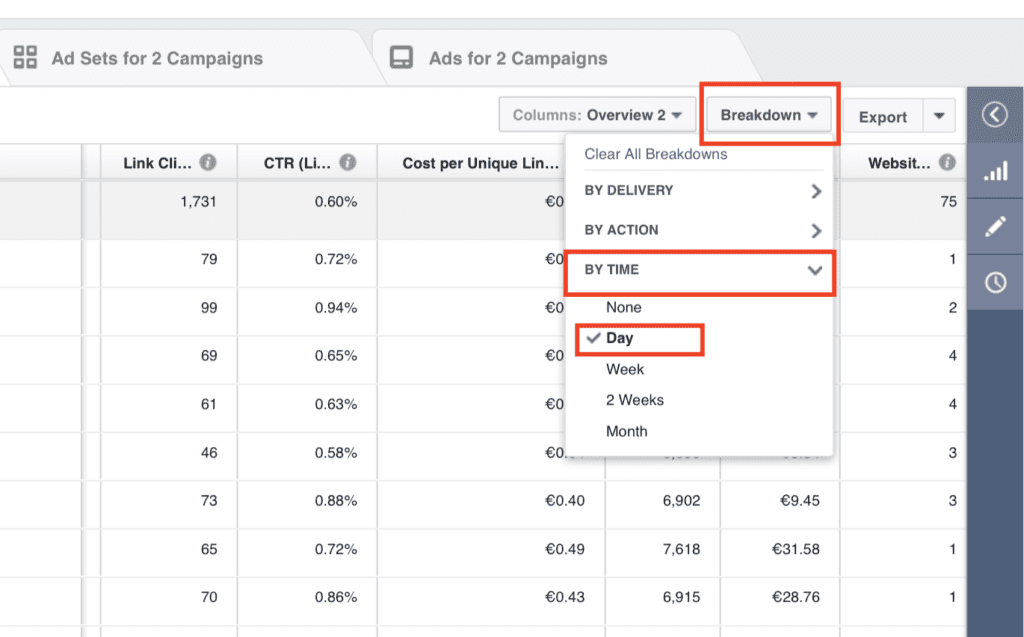
To see which of the hours or days contributed to the most conversions at the lowest possible cost per acquisition, go to “reports” in your Facebook Ads Manager and use the breakdown menu to analyze your campaigns by the hour and by day.
The performance data from your multiple Facebook campaigns can be used to discover the best, most efficient time for advertising. After determining your optimum hours, set your ads on a custom schedule, so they can reach your prospects at the right time for the highest impact.
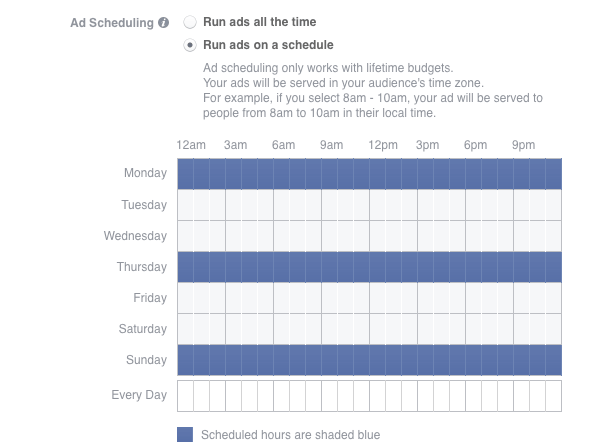
There are various audience inspector tools with which you can recognize the best time of the day for your ads to run. These metrics enable you to quickly see the exact times in which your ad is performing best, in accordance with the KPI that is most important to you.
Armed with this data, you would then be able to apply a set schedule to your ads, ensuring that your ads are running only at the most engaged periods of the day. Another important reason why you ought to keep your ad campaigns on a custom schedule is to drop your ad frequency. When viewers would see your ad campaigns less often, they don’t get bored with these ads so quickly.
Remember, Facebook ads can be very profitable as well as generate a substantial amount of quality traffic only if they are properly set up. Understanding and utilizing all of the Facebook ad conversion optimization steps opens the door to new opportunities for your business.
Step 4: Testing highly differentiated variations
Most advertisers on Facebook usually make the mistake of testing out too many ad formats all at once. If you want relevant experiment results, you need to collect a minimum of 100 conversions, either leads or clicks, per variation before you can make any conclusions; ideally, you need to collect between 300 and 500 conversions per variation.
However, waiting for so long can be really frustrating, especially when working with small ad budgets. To discover new and engaging ad elements more quickly, use the following formula:
i). First, test about 2 to 3 highly differentiated variations to find out which general theme works the best.

ii). After obtaining the winning ad, take it from the first test and improve on it with subtle variations in the next Facebook A/B test.

This streamlined method saves you the valuable resources and time you would have spent carrying out A/B testing multiple variations of all your initial ideas.
Step 5: Selecting the right campaign objective
When setting up a new Facebook ad campaign, choosing the campaign objective is the first choice you need to make.
The campaign objective informs Facebook of the ultimate goal of your advertising campaign, and also helps Facebook’s algorithms optimize your ad delivery for best results. So essentially, with the right campaign objective, you are informing Facebook on how to carry out an auto-optimization on your ad campaign.
It is therefore essential to select the right Facebook advertising goal when setting up the campaign process as this determines your cost-per-result and ads’ delivery.
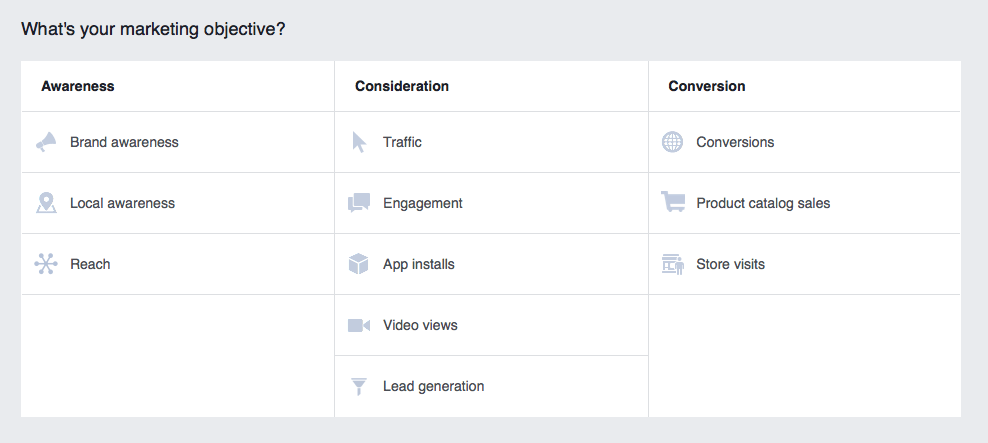
But how can you decide the campaign objective out of the many available campaign objectives? The answer is simple.
Always choose the campaign objective based on your advertising goals. For instance, if you are after new trial signups, choose the “Conversions” objective. And if your own objective is to increase your brand awareness within a specific location, choose the “Local awareness” objective. Doing it this way, Facebook will know how to carry out optimization on your ad delivery and campaign’s reach.
Step 6: Excluding converted audience from your target audience
Optimizing your Facebook and Instagram targeting is yet another way of expanding your campaign’s reach without breaking the budget.
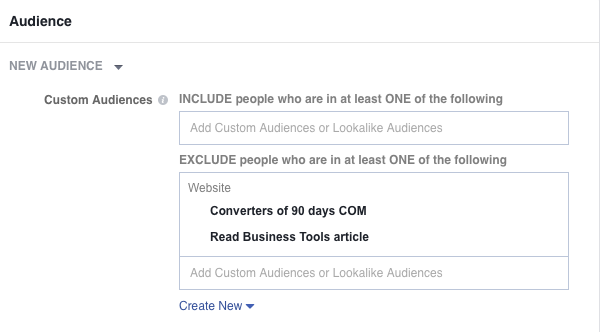
Honestly, it makes no sense to keep serving the same ad campaigns to a viewer who has already converted on the offer. Hence, this converted audience should be moved to the next marketing funnel stage where they are targeted with new messages. For instance, say you are marketing a free eBook and someone just downloaded it through your ad. Why should you spend more of your ad budget on showing the same ad to this person again?
Instead, you should exclude the converted viewers from your general campaign audience, and create a Facebook Custom Audience of them. To exclude converted audience members from your general Facebook audience, do the following:
1. Create a Custom Audience of viewers who have visited some specific web pages on your websites, like a blog article or your thank-you page.
2. Then use the EXCLUDE feature when setting up your ad campaign; this will prevent your offer from reaching out to people who have already been converted to engaging with or purchasing your product.
Step 7: Setting up auto-optimization rules
Did you know that you can set up auto-optimization rules in Facebook Ad Manager? This feature is referred to as the Facebook Automated Rules. It is available for free to anybody who advertises on Facebook.
By using these rules, 4 things can automatically happen:
- You can adjust your budget (increasing or decreasing your daily or lifetime budget by a set amount)
- You can adjust manual bids (increasing or decreasing your bid by a set amount)
- You can send a notification to the ad manager
- You can turn off your campaign, ad, or ad set
Your life as a digital marketer just got so much easier! As Facebook gets busy carrying out automated optimization on your ads based on your preset rules, you can now turn your focus back to brainstorming new campaign ideas.
To set up the Facebook automated optimization rules, follow these steps:
a. Locate your Facebook Ad Manager
b. Choose either one ad, multiple ads or ad sets
c. Click on the “Edit” icon on the top right-hand menu column.
d. Click on the “Create Rule” button
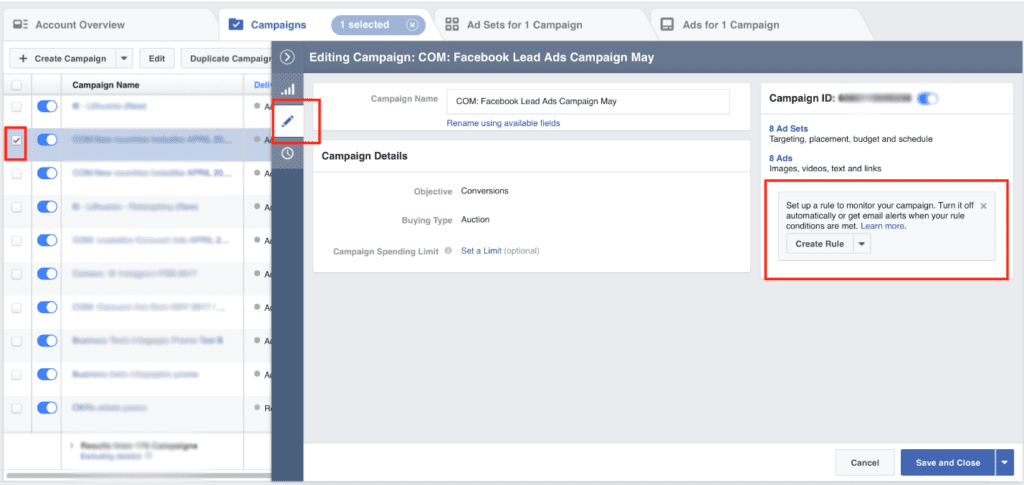
b. Now, you can set up your Facebook automated rules according to your goals and needs.
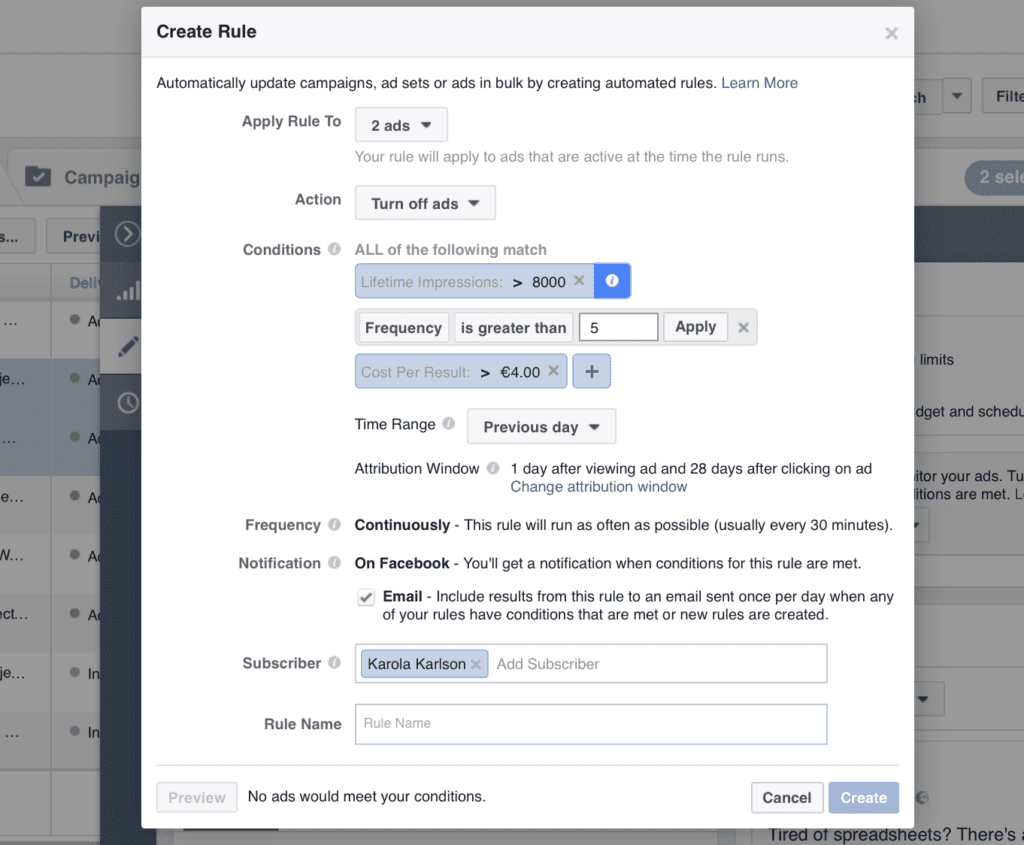
For instance, as an automated rule, you can tell Facebook to pause any ad that has reached the frequency of 7 ad views, for example, or to lower the bid on ad sets with a high CPR.
It’s also a good idea to set up an email notification system, so you can receive overviews of the last 24 hours of automated changes to your ads.
Case Studies
Hubspot, one of the major players in B2B marketing automation, decided to improve its online presence with a Facebook marketing campaign. It utilized a combination of Facebook ad conversion optimization tactics to achieve this goal. In no time – three months is really no time for such significant growth – Hubspot’s sales grew by more than 70%. How did Hubspot achieve this? It first created a Facebook brand page. Next, it ran a series of Facebook ads with clear calls to action to drive prospects straight to sales. Next, Hubspot ran a series of A/B tests that led to increased conversions and rapid sales growth.
Now Hubspot has 39% more website visitors from Facebook ads, a 15% increase in ROI from Facebook. and 71% increase in sale attributable to Facebook.
AdEspresso ran a series of right sidebar ads that underperformed despite their visually appealing nature. Instead of ditching these ads, AdEspresso decided to carry out a split test of their concepts. The initial copy said, “LIKE us for daily tips…& increase your ROI!” The new copy read: “LIKE us for pro tips…today!”
While the initial copy never got any likes, the new, more urgent copy got 70 likes within a week, close to a 2% increase.
AdEspresso didn’t really do anything big to get these dramatic results. Just a few changes in emphasis and wording of the headline did the trick, with no new images needed.
Conclusion
Facebook ad conversion optimization is a nonstop process of trial and error. Though it seems difficult at the start, ultimately it will save you a significant amount of resources and time in the long run. By familiarizing yourself with the many ways you can improve your ads’ efficacy and presence on Facebook, you are on your way to generating qualified leads that will enhance your company’s bottom line.
Dive right in, and go big. In the words of architect Daniel Burnham, “Make no small plans. They have no power to stir men’s blood.”

